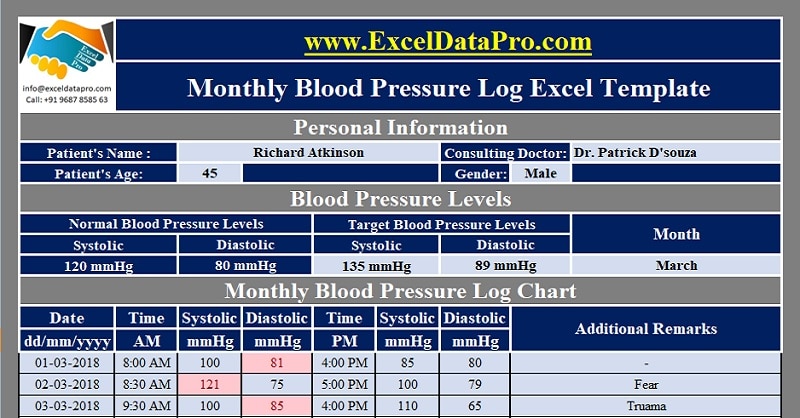
This document facilitates the regular recording and analysis of blood pressure levels on a monthly basis, providing a comprehensive overview of weekly fluctuations.
Maintaining records of blood pressure readings is crucial for managing potential health risks and preventing emergencies.
According to Global Health Observatory (GHO) data, elevated blood pressure levels are responsible for approximately 735 million deaths annually, accounting for a staggering 12.8% of total global mortality. These statistics underscore the grave importance of proactive blood pressure management as a preventative measure against life-threatening complications.
It is highly advisable to undergo routine health check-ups to monitor one’s overall well-being. In the event of a diagnosis of hypertension or high blood pressure, it becomes imperative to maintain a diligent record of blood pressure readings on a regular basis.
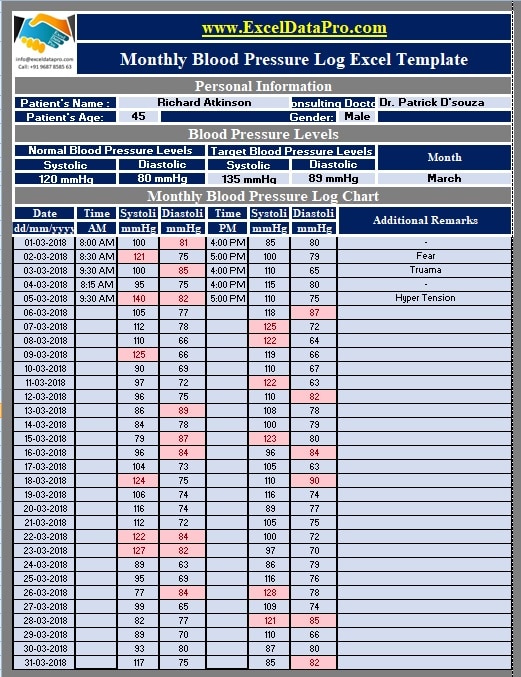
Table of Contents
Blood Pressure Log With Charts Excel Template
To facilitate this process, we have developed a user-friendly Blood Pressure Log with Graphical Charts Excel Template, complete with predefined formulas and conditional formatting features. This template automatically highlights potentially concerning high or low blood pressure readings in red, enabling users to identify and address any deviations from normal ranges promptly.
Click here to download the Monthly Blood Pressure Log With Charts Excel Template.
Click here to Download All Health & Fitness Excel Templates for ₹299.You can also download other useful excel templates like Blood Sugar Log, Simple Age Calculator, and Daily Work Schedule. All the templates are downloadable and free to use.
Let us discuss the contents of the template in detail.
Contents of Monthly Blood Pressure Log Excel Template
This template consists of 3 sheets:
- Monthly Blood Pressure Log.
- Printable Blood Pressure Log.
- Monthly & Weekly Blood Pressure Analysis Report
1. Monthly Blood Pressure Log
Blood pressure log consists of the 3 sections:
- Patient’s Personal Information
- Blood Pressure Levels
- Monthly Blood Pressure Log
Patient’s Personal Information
This section collects essential details about the patient, including their name, the consulting physician’s name, age, and gender. Additionally, there is dedicated space to record the contact information of the consulting doctor, ensuring prompt access to medical assistance during emergencies.

Blood Pressure Levels
This segment outlines the normal and target blood pressure ranges, as determined by the patient’s healthcare provider.

The Blood pressure is measured in the units mm Hg, which is millimeters of mercury.
According to the Center for Disease Control and Prevention (CDC), USA, the normal, at-risk and high levels are as below:
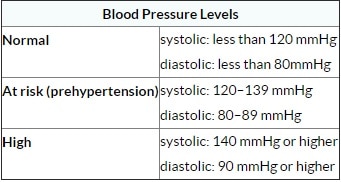
Monthly Blood Pressure Log
In this section, patients are required to log their blood pressure readings on a daily basis. The log includes the following columns:
Date: The date on which the reading was taken.
Time: The morning time at which the reading was recorded.
Systolic: This column is designated for recording the systolic blood pressure, which measures the pressure in the blood vessels during heartbeats. As mentioned earlier, the normal systolic pressure level is 120 mm Hg. If the entered value exceeds this threshold, the cell will automatically turn red to indicate a potentially concerning reading.
Diastolic: Here, the diastolic blood pressure is recorded, which measures the pressure in the blood vessels when the heart is at rest between beats. The normal diastolic pressure level is 80 mm Hg. If the entered value surpasses this level, the cell will turn red, prompting further evaluation.
Time: The late afternoon time at which the second reading of the day was taken.
Systolic: Space to log the systolic blood pressure reading for the late afternoon.
Diastolic: Space to log the diastolic blood pressure reading for the late afternoon.
Additional Remarks: Patients can utilize this column to record any additional symptoms, observations, or remarks pertaining to their condition.

Printable Blood Pressure Log
If you want to use the same in a printable format you can download and print the blank Blood Pressure Log from the link below:

Monthly & Weekly Blood Pressure Analysis With Charts
Merely recording blood pressure readings is not sufficient; regular analysis and monitoring of these levels are equally essential. To this end, we have incorporated a Monthly & Weekly Blood Pressure Analysis Report with graphical charts, enabling users to visualize and identify patterns, highs, and lows in their blood pressure readings over a specific week or month.
The monthly charts automatically populate with data from the Monthly Blood Pressure Log, providing a visual representation of the recorded readings. Separate charts are generated for the morning (AM) and afternoon (PM) recordings.
Monthly Blood Pressure AM Chart
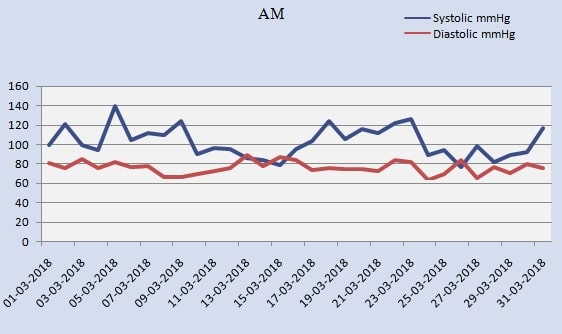
Monthly Blood Pressure PM Chart
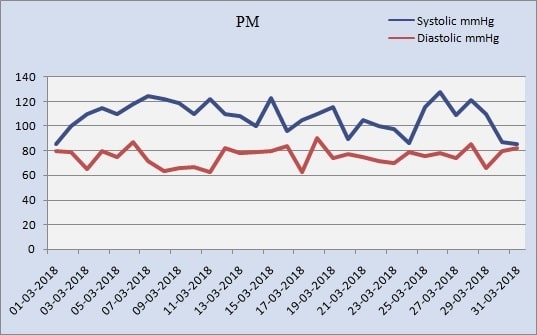
To perform the weekly analysis, just copy the data from the Monthly Blood Pressure Log and paste them in this sheet.

To conduct a weekly analysis, users can simply copy the relevant data from the Monthly Blood Pressure Log and paste it into the designated section of this sheet. This action will prompt the generation of a comprehensive analysis for the selected week, including the maximum, minimum, and average blood pressure readings for both the AM and PM recordings. Additionally, graphical charts will be displayed, offering a visual representation of the weekly data.
Weekly Blood Pressure AM Chart
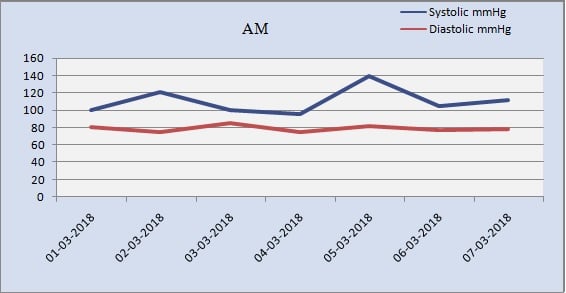
Weekly Blood Pressure PM Chart
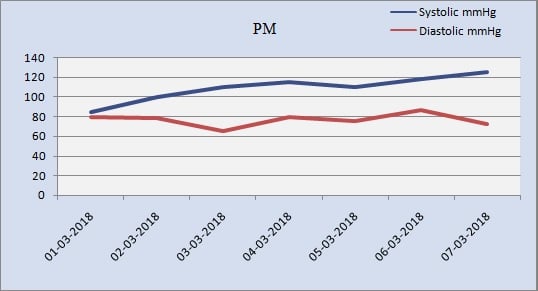
Guidelines for Measuring Blood Pressure
- Take three consecutive readings during each measurement session, allowing at least one minute between each reading. Ensure that the equipment used is properly calibrated and validated, and that the cuff size and fit are appropriate.
- Measure blood pressure twice daily: once in the morning and once in the late afternoon. Attempt to take readings at approximately the same time each day to establish a consistent routine.
- Adopt a comfortable seated position with both feet flat on the floor, and allow for a five-minute rest period before commencing the measurement. Position the arm being used for the reading at the same level as the heart, resting it on a table or surface. Avoid engaging in conversation during the measurement process.
Source: Heart.org
Disclaimer: This template provides a general overview and should not be considered a substitute for professional medical advice. It is strongly recommended to consult with a qualified healthcare professional (HCP) to determine the appropriate normal and target blood pressure ranges for your individual circumstances, as well as to address any potential complications or concerns.
We extend our gratitude to our readers for their ongoing support, engagement, and active participation across various social media platforms.
If you have any queries please share in the comment section below. We will be more than happy to assist you.